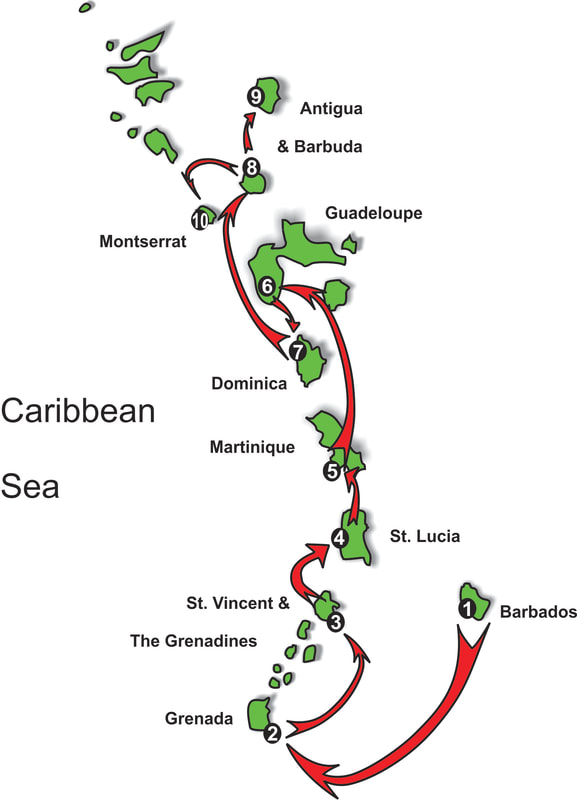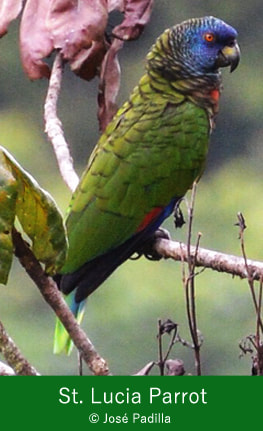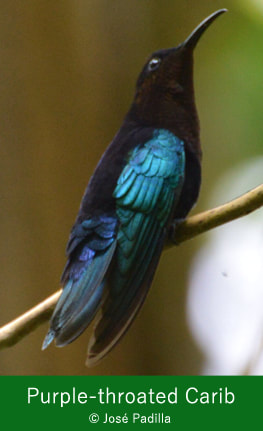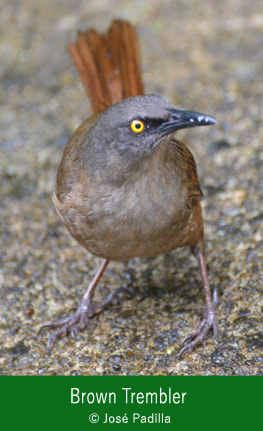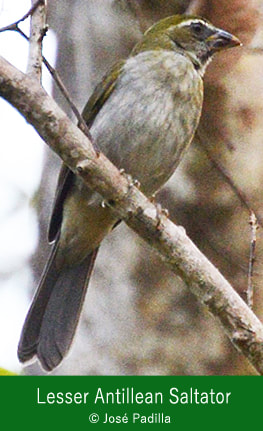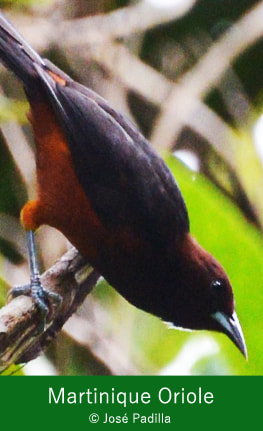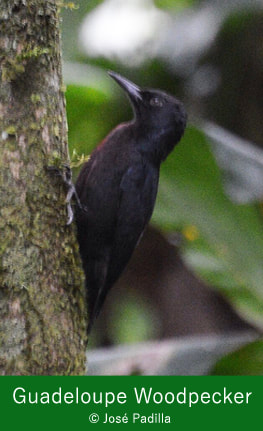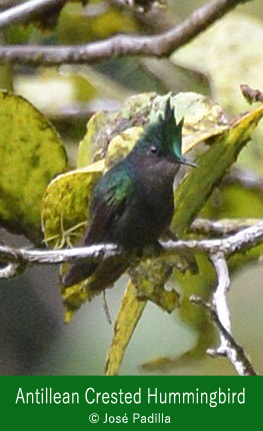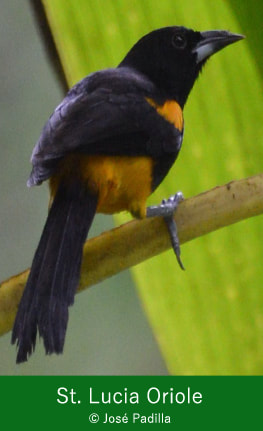<< LESSER ANTILLES BIRDING TOURS
An island-by-island birding tour to observe all possible endemic bird species in the Lesser Antilles.
Quick Info Literature & Audio Photo Gallery Bird Checklist COVID-19
|
The Lesser Antilles are 21 small (main) islands, most of them volcanic in origin, which are forming an arc of about 5,170 sq. mi. (8,320 sq. km), embracing the eastern border of the Caribbean Sea. These islands are named and grouped by their respective position to the prevalent winds. The Leeward Islands are in the northern section of the arc, including Dominica, Marie Galante, Guadeloupe, La Desirade, Montserrat, Antigua, Nevis, St. Kitts, Barbuda, St. Eustatius, Saba, St. Barthélemy, St. Martin, and Anguilla. The Windward Islands are in the southern section, including Grenada, The Grenadines, St. Vincent, Barbados, St. Lucia, and Martinique.
The Lesser Antillean avifauna comprises more than 440 recorded species. About 26 of these birds are globally threatened and 28, or more (variable, depending on the authority), are considered endemic to this archipelago (plus other Caribbean specialties), including some rare and beautiful species such as Grenada Dove, Purple-throated Carib, Blue-headed Hummingbird, Imperial Parrot, St. Lucia Parrot, St. Vincent Parrot, Grenada Flycatcher, Brown Trembler, Martinique Oriole, Whistling Warbler, Plumbeous Warbler, Barbuda Warbler, Lesser Antillean Tanager, St. Lucia Black Finch, among others (see Bird Checklist). One species from St. Lucia, Semper's Warbler, unfortunately seems to be extinct today. These islands are also a very good scenario for Old World vagrant species. WILLIAM SUAREZ BIRDING TOURS offers ornithological survey programs to this beautiful archipelago, providing magnificent opportunities to explore the unique and varied insular habitats of the Lesser Antilles. Our birding itineraries (see map) visit ten important islands with the highest biodiversity and therefore richness of avifauna, both in terms of endemism and species numbers. We will be birding in the highlands, mangrove, dry woodland and coastal scrub forests, and along coastlines. Some early morning starts are necessary and there is a night (or more) birding session as well. Each tour begins in Barbados and ends in Antigua, both islands located in the southern and northern extremes of the Lesser Antillean Arc, respectively. |
Lesser Antilles
Tour Route: 1) Barbados, 2) Grenada, 3) St. Vincent , 4) St. Lucia, 5) Martinique, 6) Guadeloupe, 7) Dominica, 8) Antigua, 9) Barbuda, 10) Montserrat
DAY 1: Welcome to BarbadosArrival and transfer from Bridgetown Grantley Adams International Airport (BGI) in Barbados. We will be waiting for you at the airport for your transportation to the hotel, where members of the group will check into their reserved rooms. At 6:00 p.m., participants will meet the leader in the lobby for a welcome meeting and discussion of trip plans before dinner. Night on Barbados.
DAY 2: Barbados & GrenadaThis morning we will be birding in Barbados. Our main objective is the endemic Barbados Bullfinch (Loxigilla barbadensis). After our search for this species at our first stop, we will go to some areas to search for vagrants (depending on the tour dates) and other birds. Our morning at Barbados will ends having a short flight to the island of Grenada. After lunch there we will try to get our first view of the endemic and rare Grenada Dove (Leptotila wellsi) in the dry forest of the island. Night on Grenada.
DAY 3: Grenada & Saint VincentIn the morning we will drive again to the Grenada Dove's habitat and will spend most of the morning there. During our exploration, and in other habitats throughout the island of Grenada, will be possible some other species including Hook-billed Kite, Lesser Antillean Tanager, Rufous-breasted Hermit, and other West Indian specialties. In the late afternoon we will be flying to St. Vincent where we will be conducting our first birding session at night, for the endemic Lesser Antillean Barn Owl. Night on St. Vincent.
DAY 4: Saint VincentEarly in the morning we will depart for the mountain habitats in St. Vincent as we'll be searching for our target birds there: St. Vincent Parrot (Amazona guildingii) and the Whistling Warbler (Catharopeza bishopi). In the afternoon, we will explore the grounds of the Kingstown Botanical Garden for additional and possibly better views of the parrots, but also some other specialties including the Common Black Hawk, which sometimes is possible. Other bird species in this island are the endemic subspecies of Lesser Antillean Bullfinch (Loxigilla noctis crissalis), Bananaquit (Coereba flaviola atrata), and more. Night on St. Vincent.
DAY 5-6: Saint LuciaEarly in the morning, after breakfast, we will have our flight depart to St. Lucia. In the afternoon, our birding session will be in the Union Forestry Division Reserve. This locality is home to some endemic and target species such as the St. Lucia Warbler (Setophaga delicata), Gray Trembler (Cinclocerthia gutturalis), Lesser Antillean Pewee (Contopus latirostris oberi), Scaly-breasted Thrasher (Allenia fusca), Ruddy Quail Dove, and more. Other bird species from St. Lucia include St. Lucia Black Finch, St. Lucia Oriole, Red-billed Tropicbird, Brown Booby, Magnificent Fregatebird, Little Egret, Lesser Antillean Swift, Green-throated Carib, endemic subspecies of Broad-winged Hawk (Buteo platypterus rivierei), Common Ground Dove (Columbina passerina antillarum), Antillean Crested Hummingbird (Orthorhyncus cristatus exilis), Lesser Antillean Flycatcher (Myiarchus oberi sanctaeluciae), Pearly-eyed Thrasher (Margarops fuscatus klinikowskii), among others.
We will leave early in the morning to the reserve in the central part of the island where we will be exploring the highlands, especially for our target St. Lucia Parrot. If time permits, we can explore additional localities in the northeastern section of St. Lucia for some possible birds such as endemic subspecies of White-breasted Thrasher (Ramphocinclus brachyurus), Rufous Nightjar, and more. Night on St. Lucia.
DAY 7-10: Martinique & GuadeloupeIn the morning we will take our flight to Martinique. The only endemic bird of this island is the Martinique Oriole (Icterus bonana), but many other Lesser Antillean specialties are present here. Time permitting and depending on our final flight schedule, we will try to conduct our first birding excursion in this island. During the first, of the two next days, we will be leaving the hotel early in the morning and moving to the dry coastal scrub habitat for two target species: White-breasted Thrasher and the Lesser Antillean Saltator (Saltator albicollis). As soon as we finish with our target species here, we will drive to the habitats of the Martinique Oriole in the mountain forest. Other bird species also possible here are Rufous-throated Solitaire, Gray Trembler and Blue-headed Hummingbird. Our second day in Martinique is to search for any missed bird species and have a relaxing time during the afternoon. In the evening we will flight to Guadeloupe. First night in Martinique, second night in Guadeloupe.
After our breakfast at the hotel in Guadeloupe, we will drive to the mountains where in the forests of Basse Terre we will conduct or first birding exploration. During our morning in this locality we will search for the Guadeloupe Woodpecker (Melanerpes herminieri), the only endemic woodpecker species in the entire arc of the Lesser Antilles. Other possible birds here include Forest Thrush (Turdus lherminieri), Brown Trembler (Cinclocerthia ruficauda), Bridled Quail-Dove (Geotrygon mystacea), among others. Our afternoon will be devoted to birding in the vicinity of Pointe des Chateaux for some sea birds, including Bridled Tern, Magnificent Fregatebird, and more. Night in Guadeloupe.
DAY 11-12: DominicaMorning for flight to Dominica. Today our available time for birding in the afternoon depends on our flight schedule once again. Next day, after an early morning departure, we will drive to the mountain ranges of Dominica for endemics. It is necessary to reach the forest during the most active period for our target birds, the Imperial Parrot (Amazona imperialis) and the Red-necked Parrot (Amazona arausiaca). Other species that can be found during this day include Forest Thrush, Plumbeous Warbler (Setophaga plumbea), Red-legged Thrush, Blue-headed Hummingbird (Cyanophaia bicolor), Lesser Antillean Pewee, the endemic subspecies of House Wren, among others. Night in Dominica.
DAY 13: AntiguaWe will arrive in Antigua during the morning on a flight from Dominica. This is a relaxing day of easy birding. In the afternoon, we will explore some localities for waterfowl, shorebirds, and wading birds including West Indian Whistling-Duck. Night in Antigua.
DAY 14: Visit to Montserrat from AntiguaMorning flight, or ferry ride, to visit Monserrat. Today our target bird will be the endemic Montserrat Oriole (Icterus oberi). Other birds there include the endemic subspecies of the Forest Thrush. Night in Antigua.
DAY 15: Visit to Barbuda from AntiguaMorning flight, ferry ride, to visit Barbuda. Our target bird for the day is the endemic Barbuda Warbler (Setophaga subita). Visiting the Codrington Lagoon and the cliffs of the island we will have excellent views of the Magnificent Fregatebirds, Red-billed Tropicbirds, some terns and shorebirds. Night in Antigua.
DAY 16: Departure & Good-bye to AntiguaDay of transfer from the hotel to the V. C. Bird International Airport (ANU), for departures of the members of the group.
|
Alterations in Tour Itineraries: Owing to a variety of circumstances, a planned itinerary as appears on this website, can be changed or modified locally by the leader to accommodate particular weather conditions, bird activity, human disturbances, unexpected situations, or any other reasons considered by the leader. WILLIAM SUAREZ BIRDING TOURS reserves the right to change any itinerary.





